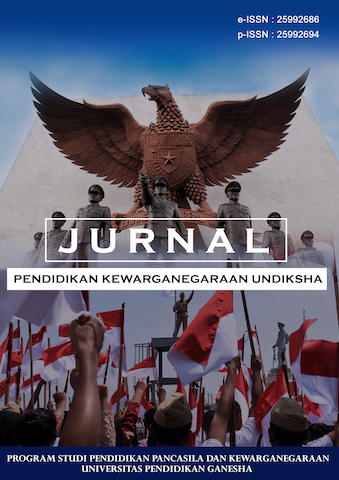FAKTOR KRIMINOGENIK TINDAK PIDANA NARKOTIKA DI LEMBAGA PEMASYARAKATAN NARKOTIKA KELAS IIA PEMATANG SIANTAR
Keywords:
Criminology, Drugs, NarcoticsAbstract
Drugs are illegal substances that can damage the human brain and body when used. In Indonesia, drug use continues to increase every year. The research on drug use conducted at the Pematang Siantar class II A correctional institution aims to determine the criminogenic factors of narcotics use, the theory used in this research is the criminogenic theory of tension and social control, because this research uses research on criminogenic factors. The method used in this research is qualitative research method with data collection techniques through interview, observation and documentation techniques, then the data that has been collected will be analyzed through the process of data reduction, data presentation and providing conclusions on what has been researched. The results of the study found the fact that the factor of using narcotics prohibited goods in the Pematang Siantar class IIA prison is based on economic factors, past events such as bullying in family and friendships, lack or inattention of the family to prisoners, even so other facts were found that the prisoners still had dreams to be achieved despite having dealt with prison.
References
Alam, A.S. 2010. Pengantar Kriminologi. Makassar. Pustaka Refleksi Books. hlm 21
Bawengan,G.W. 1977. Hukum Pidana Dalam Teori dan Praktek. Jakarta.Prada Paramita. hlm 90
Bonger, W.A. 1995. Pengantar Tentang Kriminologi. Jakarta. Ghalia. hlm 76 Dewi, W. P. (2019). Penjatuhan Pidana Penjara Atas Tindak Pidana Narkotika Oleh Hakim Di Bawah Ketentuan Minimum Ditinjau Dari Undang-Undang Nomor 35 Tahun 2009 Tentang Narkotika. Jurnal Hukum Magnum Opus, 2(1), 55–73.
Furqan, H., & Sidiq, M. (2019). Efektifitas Pembebasan Bersyarat Terhadap Narapidana Residivis Narkotika (Studi Kasus Di Rutan Kelas II B Kota Sigli). Jurnal Justisia: Jurnal Ilmu Hukum, Perundang-Undangan Dan Pranata Sosial, 3(1), 71–89.
Gaylord, M. S. , & Galliher, J. F. (2020). The Criminology of Edwin Sutherland. Routledge.
Handoyo, Iqbal Septiaji, Tsania Nurul Azkia, and Riska Andi Fitriono. "Faktor Kriminogen Dalam Kasus Penyelundupan Benih Lobster." RESAM Jurnal Hukum 7.2 (2021): 89-105.
J.E., Sahetapy. 1981. Teori Kriminologi Suatu Pengantar. Jakarta. PT.Citra Aditya Baku. hlm 7
Karelina, Y. (2021). Faktor Kriminologi Narapidana Residivis Pencurian di Lembaga Pemasyarakatan Kelas II B Kota Tasikmalaya. Indonesian Journal of Criminal Law and Criminology, 2(2).
Lawrence, M., Friedman, M., Khozim, & Mangunsong, N. (2021). Dampak Hukum, Kelompok Sebaya dan Subkultur: Seri Sistem Hukum Perspektif Ilmu Sosial. Nusamedia.
Martín, A. M., Padrón Goya, M., & Redondo, S. (2019). Early narratives of desistance from crime in different prison regimes. European Journal of Psychology Applied to Legal Context, 11(2), 71–79.
Meka AlMukharomah, & Wibowo, P. (2019). Faktor Pendorong Residivisme Tindak Pidana Narkotika Di Lembaga Pemasyarakatan Kelas Ii B Arga Makmur. Jurnal Pendidikan Kewarganegaraan, 10(1), 1–20.
Mongardini, C. (2018). Robert K. Merton and Contemporary Sociology.
Neuman, W. L. (2016). Metodologi Penelitian Sosial : Pendekatan Kualitatif dan Kuantitatif (7th ed.). PT Indeks.
Noviarini, Ni Putu Wulan, Ni Putu Rai Yuliartini, and Dewe Gede Sudika Mangku. "Tinjauan Kriminologis Terhadap Tindak Pidana Penyalahgunaan Narkotika Dikalangan Remaja Di Kabupaten Buleleng." Jurnal Komunitas Yustisia 4.2 (2021): 416-426.
Parlin. (2021). Peran kepolisian daerah sumatera utara (polda-su) dalam penegakan hukum terhadap tindak pidana pemilihan umum.
Regianda, K. (2021). Faktor Penyebab Dan Penanggulangan Tindak Pidana Penyalahgunaan Narkotika Yang Dilakukan Di Kalangan Mahasiswa. Jurnal Ilmu Hukum, 14(2).
Saukah, A., Sukarnyana, I. W., & Waseso, M. G. (2000). Pedoman Penulisan Karya Ilmiah (PPKI).
Situmorang, V. H., Ham, R., & Kav, J. H. R. S. (2019). Lembaga Pemasyarakatan sebagai Bagian dari Penegakan Hukum. Jurnal Ilmiah Kebijakan Hukum. 2019, 13(1), 95.
Subandri, A., Widyarsono, T., & Suradi. (2021). Menumpas Bandar Menyongsong Fajar: Sejarah Penanganan. Prenada.
Sugiyono. (2020). Metode Penelitian Kualitatif. Alfabeta.
Susetiawan, , Bahruddin, & Pinem, Milda L. (2022). Pembangunan Sosial Dan Kesejahteraan: Jejak Pemikiran, Pendekatan, dan Isu Kontemporer. Gajah Mada University Press.
Syifawaru, S. (2022). Tinjauan Kriminologi Terhadap Residivis Anak Sebagai Pelaku Tindak Pidana Pelecehan Seksual. Jurnal of Lex Generalis, 3(2).
Undang – Undang Nomor 35 tahun 2009 tentang Narkotika. (n.d.).
Wardani, N. S., & Wibowo, P. (2022). Upaya Meningkatkan Motivasi Narapidana Melalui Pondok Pesantren Guna Menekan Angka Residivis pada Lapas Purwodadi. Jurnal Pendidikan Dan Konseling (JPDK), 4(6), 3195– 3199.
Williams, F. P. (2019). Imagining Criminology: An Alternative Paradigm. Routledge.
Yuliartini, Ni Putu Rai. "Kenakalan Anakdalam Fenomena Balapan Liardi Kota Singaraja Dalam Kajian Kriminologi." Jurnal Advokasi 9.1 (2019).
Downloads
Published
Issue
Section
License

This work is licensed under a Creative Commons Attribution-ShareAlike 4.0 International License.
Authors who publish with the Jurnal Pendidikan Kewarganegaraan Undiksha agree to the following terms:
- Authors retain copyright and grant the journal the right of first publication with the work simultaneously licensed under a Creative Commons Attribution License (CC BY-SA 4.0) that allows others to share the work with an acknowledgment of the work's authorship and initial publication in this journal.
- Authors are able to enter into separate, additional contractual arrangements for the non-exclusive distribution of the journal's published version of the work (e.g., post it to an institutional repository or publish it in a book), with an acknowledgment of its initial publication in this journal.
- Authors are permitted and encouraged to post their work online (e.g., in institutional repositories or on their website) prior to and during the submission process, as it can lead to productive exchanges, as well as earlier and greater citation of published work. (See The Effect of Open Access)










